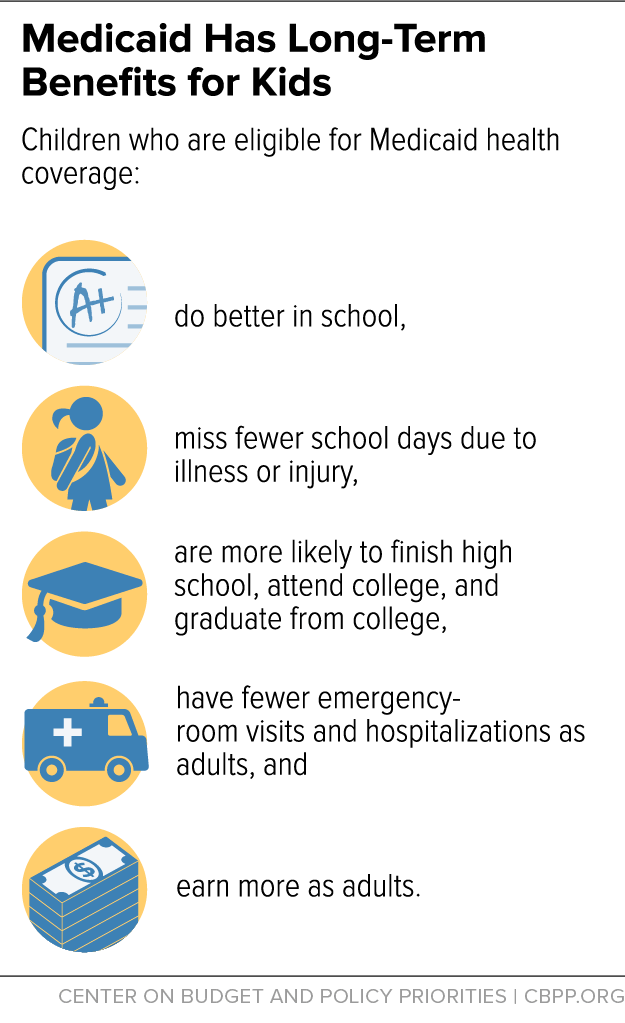Medicaid provides affordable and comprehensive health coverage to over 30 million children, improving their health and their families’ financial well-being.[1] In addition to the immediate health and financial benefits that Medicaid provides, children covered by Medicaid experience long-term health and economic gains as adults.[2] Many children receive Medicaid-covered health care not only at the doctor’s office, but also often at school.
For students with disabilities, schools must provide medical services that are necessary for them to get an education as part of their special education plans, and Medicaid pays for these services for eligible children. And Medicaid’s role in schools goes beyond special education, as it also pays for health services that all children need, such as vision and dental screenings, when they are provided in schools to Medicaid-eligible children. Schools can also help enroll eligible but unenrolled children in Medicaid or the Children’s Health Insurance Program (CHIP), and connect them to other health care services and providers. Medicaid also helps schools by reducing special education and other health care-related costs, freeing up funding in state and school budgets to help advance other education initiatives.
Capping and cutting federal Medicaid funding, as the House Republicans’ American Health Care Act would do, would jeopardize critical health-related services for students and put an important source of funds for schools and states at risk.
The Individuals with Disabilities Education Act (IDEA) ensures that children with disabilities have access to public education in the least restrictive environment based on their individual needs. Under the IDEA, children’s needs are identified in an individualized education plan (IEP), which details the education and related services they need. In many cases the IEP includes services that Medicaid covers for children, such as physical and speech therapy.[3]
Unlike Medicaid, funding for IDEA is appropriated annually and at insufficient levels. Although the federal government committed in IDEA to provide 40 percent of the cost to educate children with disabilities, it has never met even half of that commitment. For example, in 2015, federal IDEA funding covered only 16 percent of the cost to educate children with disabilities, leaving the remaining costs to states and local governments. Since 2009, this cost shift has averaged about $17 billion each year.[4]
Despite the lack of adequate federal funding, IDEA requires local education agencies to prioritize the educational needs of students with disabilities. Without another source of revenue, states and schools must offset the additional costs associated with special education using general education dollars. Medicaid helps fill this gap by providing reimbursement for health care services that are necessary for students with disabilities to succeed in school when the following conditions are met: the services are listed in the child’s IEP; the child is enrolled in Medicaid; Medicaid covers the service; and the school is recognized as a Medicaid provider. Schools’ ability to leverage Medicaid funding ensures that they can provide the wide range of services needed to educate students with disabilities and ensure their compliance with IDEA requirements.
Helping Kids Stay Healthy and Succeed Academically
Medicaid coverage has a significant positive impact not only on children’s health, but also on their educational attainment and job earnings. Children covered by Medicaid during their childhood have better health as adults, with fewer hospitalizations and emergency room visits, research shows.[5] Moreover, children covered by Medicaid are more likely to graduate from high school and college and have higher wages and pay more in taxes as adults.[6] (See Figure 1.)
Medicaid’s role in schools goes beyond ensuring that students with disabilities have access to the medical services they need to succeed. Medicaid provides support for health care services delivered in school, which benefit all children — not just those enrolled in Medicaid. In a recent survey of school superintendents, almost half reported that they use the reimbursement their districts receive for services provided to Medicaid-eligible children to expand health-related services and supplies.[7] This includes programs that monitor the health care needs of eligible children with certain conditions such as asthma and diabetes as well as operating clinics within schools to provide dental care to Medicaid-eligible children.
Medicaid pays for services and supplies provided to Medicaid-eligible children under its Early Periodic Screening Diagnostic and Treatment (EPSDT) benefit. Under this benefit, children and adolescents under the age of 21 have guaranteed access to a robust set of comprehensive and preventive health services, including regular well-child exams; hearing, vision, and dental screenings; and other services to treat physical, mental, and developmental illnesses and disabilities. The EPSDT benefit also covers medically necessary supplies and equipment that help students in schools, such as hearing aids, eyeglasses, wheelchairs, and other assistive technology to help students hear and see.
Schools serve as an important pathway to coverage for low-income children by helping their families enroll them in Medicaid and CHIP. Schools are natural places to help enroll uninsured children: they’re an easy place to identify uninsured children; they’re trusted places; they’re geographically accessible; they have experience communicating with their communities through established information-sharing methods; and they can collaborate with partners to assist in helping children and their families apply for coverage.[8]
Over half of surveyed school superintendents reported that they had taken steps to increase Medicaid enrollment of children in their schools.[9] Medicaid reimburses schools for their outreach and enrollment activities, which helps both students and schools. Children gain coverage, which helps them stay healthy and succeed in school, and Medicaid reimbursement allows schools to expand health care services and programs.
In addition to using Medicaid to cover costs of outreach and enrollment activities, schools use the program to help connect children to services they need outside school. Forty percent of surveyed school superintendents reported that they use Medicaid funding to facilitate outreach and coordination services to refer children to such services, including mental health services and food assistance.[10]
In 2015, Medicaid paid for nearly $4 billion in school-based health care services, including both special education and EPSDT services provided outside of special education.[11] (See Appendix Table 1 for state-by-state data.) By comparison, schools received about $12 billion in federal IDEA funding in 2015.[12]
While Medicaid spending on school-based health services represents less than 1 percent of total Medicaid spending, it’s significant for schools. Cutting federal Medicaid funding would reduce the access and quality of care provided to students while also hurting school budgets.
The House Republicans’ bill to repeal the Affordable Care Act, the American Health Care Act (AHCA), would cut federal Medicaid spending by $839 billion over ten years. The AHCA would not only effectively end the Affordable Care Act’s Medicaid expansion but also radically change Medicaid’s financing structure by capping and cutting federal funding by requiring states to choose between a per capita cap or a block grant.[13] That would shift significant costs and risks to states, with the cuts growing larger over time. To compensate, states would have to increasingly cut Medicaid eligibility, benefits, and provider payments. Given the magnitude of the federal cuts, states would likely have to cut funding for Medicaid services provided in schools, which means schools would find it difficult to maintain their current level of special education and health care spending.
Moreover, in states that opted for a block grant, children would likely be left with few federal protections related to their Medicaid coverage because states would no longer have to comply with most federal Medicaid requirements. That would, for example, allow states to no longer cover the guaranteed benefits children receive under EPSDT.
Radically restructuring and cutting Medicaid funding — whether through a per capita cap or a block grant — would thus jeopardize schools’ ability to purchase needed medical equipment, connect children to other health care services, and implement health monitoring programs that benefit the entire school population by keeping all children, not just those enrolled in Medicaid, healthy and successful in school.
In addition to reimbursing schools for direct medical care they provide to eligible students, Medicaid funding helps schools pay the salaries of their health care and ancillary staff who provide important services and support to many students, not just those with Medicaid coverage. In 2017, 68 percent of school superintendents reported that they used Medicaid funding to keep school nurses, school counselors, speech therapists, and other health professionals on staff.[14] Any cuts to Medicaid could jeopardize the benefits these health care professionals provide. Moreover, because school districts are often large employers, Medicaid plays an important role in creating and sustaining jobs in local communities. Radical changes to Medicaid financing could lead schools to layoff school personnel whose salaries are paid by Medicaid.
State education budgets benefit from Medicaid, too. By leveraging Medicaid and federal IDEA funding, states are less likely to have to use general education dollars to pay special education costs. Because IDEA requires school districts to prioritize funding special education, schools would have to shift resources, such as diverting funds from general education or other important areas of the state budget, to absorb a Medicaid funding cut under a per capita cap or block grant. A resulting cut in general education funding could impede states’ ability to help schools implement proven reforms such as hiring and retaining excellent teachers, reducing class sizes, and expanding the availability of high-quality early education — keys to helping children thrive in school.
| TABLE 1 |
|---|
| State |
Total |
Federal |
|---|
| Alabama |
$34,562,110 |
$17,281,056 |
| Alaska |
$4,384,800 |
$2,192,400 |
| Arizona |
$42,733,682 |
$27,049,503 |
| Arkansas |
$58,648,205 |
$36,769,009 |
| California |
$180,286,733 |
$90,147,654 |
| Colorado |
$65,214,047 |
$32,945,196 |
| Connecticut |
$83,677,404 |
$41,838,703 |
| Delaware |
$8,528,600 |
$4,626,906 |
| Dist. Of Col.* |
$(8,236,489) |
$(5,765,430) |
| Florida |
$124,715,692 |
$63,206,315 |
| Georgia |
$52,097,071 |
$30,932,107 |
| Hawaii** |
$0 |
$0 |
| Idaho |
$35,770,614 |
$25,665,305 |
| Illinois |
$286,388,260 |
$144,391,000 |
| Indiana |
$15,939,697 |
$9,473,111 |
| Iowa |
$102,106,503 |
$56,708,832 |
| Kansas |
$67,095,810 |
$36,959,435 |
| Kentucky |
$34,518,428 |
$20,872,855 |
| Louisiana** |
$0 |
$0 |
| Maine |
$42,800,723 |
$26,484,778 |
| Maryland |
$78,895,689 |
$39,503,532 |
| Massachusetts |
$146,998,191 |
$73,506,866 |
| Michigan |
$250,237,503 |
$162,144,442 |
| Minnesota |
$106,433,753 |
$53,210,621 |
| Mississippi |
$8,335,706 |
$4,556,343 |
| Missouri |
$39,847,998 |
$19,924,000 |
| Montana |
$55,034,916 |
$35,666,244 |
| Nebraska |
$26,207,529 |
$13,303,816 |
| Nevada |
$15,784,497 |
$10,158,902 |
| New Hampshire |
$52,973,368 |
$26,531,270 |
| New Jersey |
$286,660,460 |
$143,432,313 |
| New Mexico |
$30,483,045 |
$18,044,216 |
| New York |
$273,563,018 |
$136,781,511 |
| North Carolina |
$142,001,148 |
$87,216,152 |
| North Dakota |
$1,851,975 |
$925,971 |
| Ohio |
$81,546,862 |
$51,023,143 |
| Oklahoma |
$2,739,518 |
$1,706,720 |
| Oregon |
$5,188,389 |
$3,300,296 |
| Pennsylvania |
$253,324,530 |
$131,095,440 |
| Rhode Island |
$64,900,209 |
$32,464,511 |
| South Carolina |
$33,630,157 |
$21,429,977 |
| South Dakota |
$9,661,644 |
$4,881,539 |
| Tennessee** |
$0 |
$0 |
| Texas |
$444,382,561 |
$250,343,667 |
| Utah |
$32,284,475 |
$21,801,456 |
| Vermont |
$8,558 |
$4,810 |
| Virginia |
$58,719,643 |
$29,359,835 |
| Washington |
$9,321,688 |
$4,664,392 |
| West Virginia |
$24,694,593 |
$17,621,320 |
| Wisconsin |
$187,671,697 |
$107,416,062 |
| Wyoming** |
$0 |
$0 |
| Total |
$3,954,615,210 |
$2,163,798,102 |

